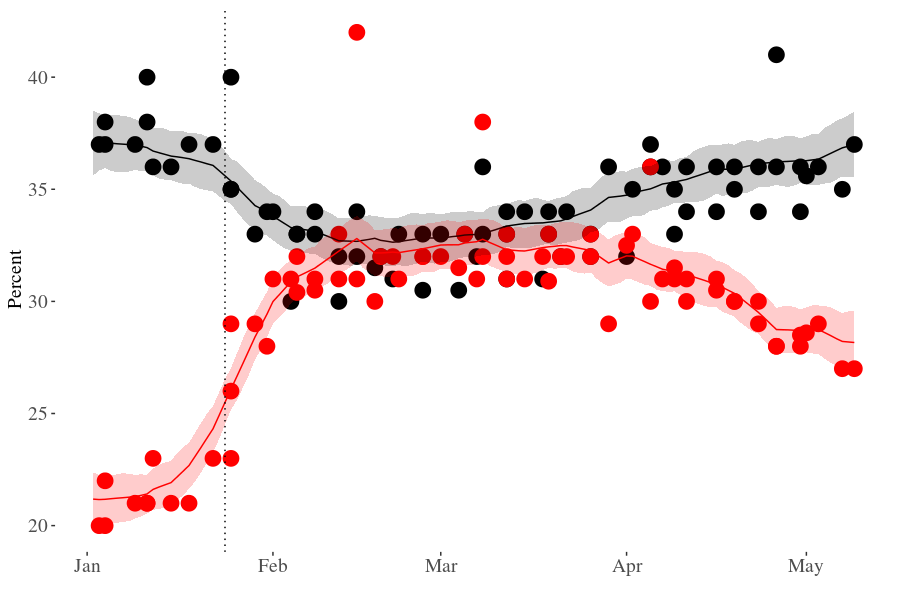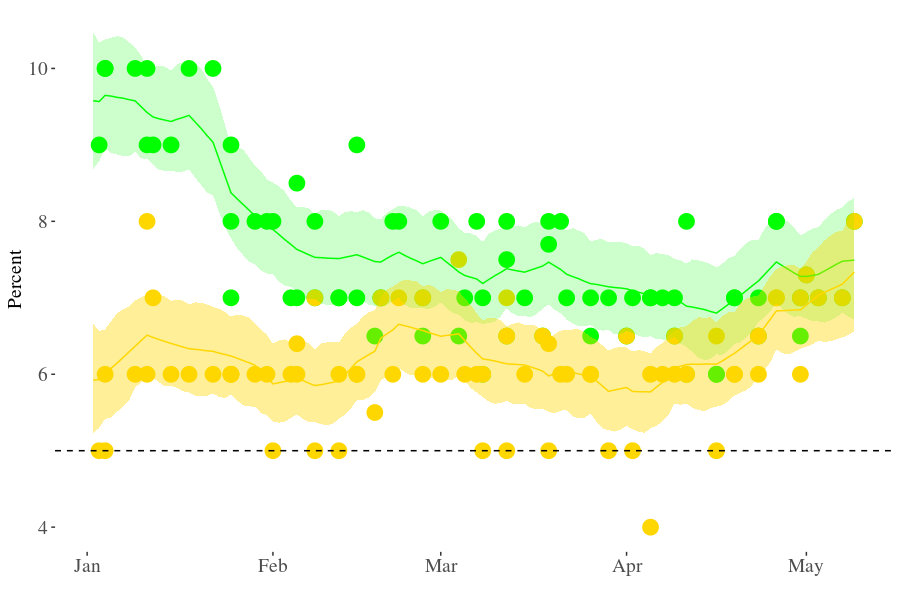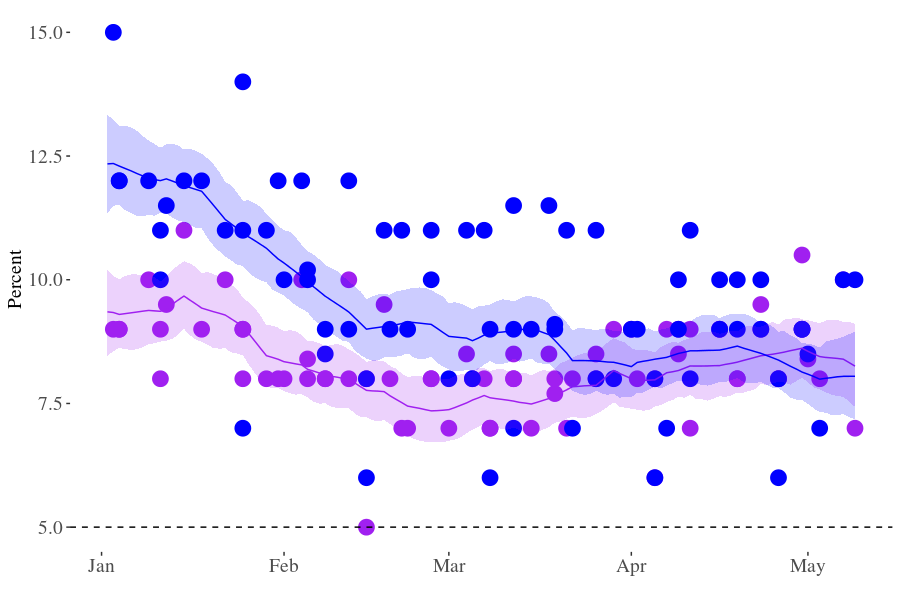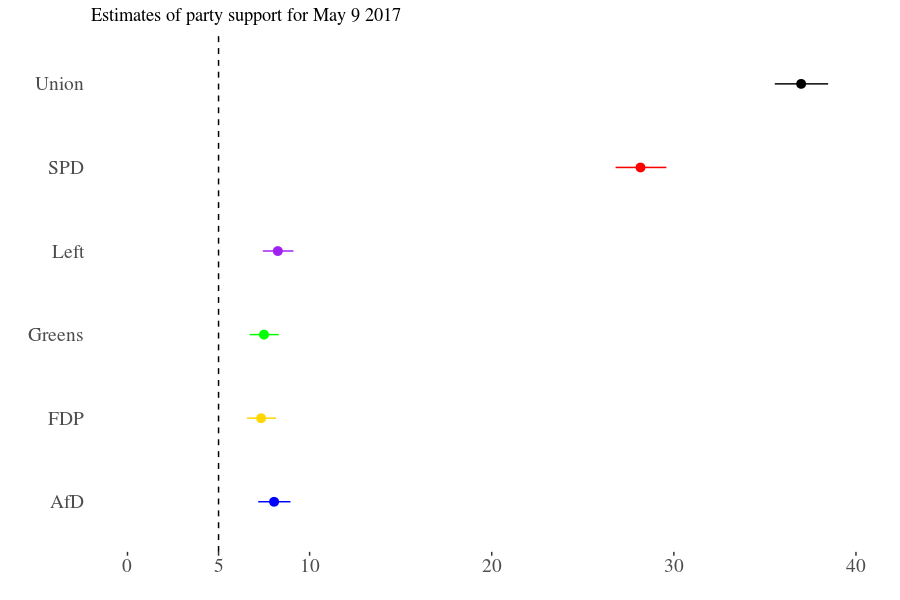13 new polls show some movement in April
It is four and half months until the September election, and things are getting a little more interesting. Everyone around here is happy that Macron saved the EU and defeated populism in one fell swoop (or maybe not), but I still love a nice parochial state election. And we had a good one: Last Sunday, the small northern state of Schleswig-Holstein went to the polls. The current coalition (SPD, Greens, and the Danish/Frisian minority party SSW) is unusual enough, and they lost their majority of a single seat. The CDU won a bit, the SPD lost a bit more, but for them, it’s a disaster since expectations were high (Schulz effect, anyone?). The Left and the Pirates are out, and both the Greens and the FDP are in double digit territory. Certainly, this is not a federal trend. The AfD made into the Landtag for the 12th (?) time in a row, but barely (5.9%).
Further to the south, North Rhine-Westphalia will have its own election on next Sunday. Here, the red-green coalition is in trouble, because the Greens are doing very poorly, and SPD support is lacklustre. The CDU, which has been trailing the SPD for a long time, is catching up, and both the AfD and the FDP are doing ok, though not great. It’s not quite clear if the Left will make it, and the Pirates (remember?) seem poised to lose their last delegation in a state parliament. What ever happens here will inevitably been read as a bellwether, because of the state’s size (it is home to almost a quarter of Germany’s population), and because it is the last state election before the federal election.
Meanwhile, 13 surveys that poll federal voting intentions have been published. Taken together, there are now 17 polls to track the developments in April (and several that already extend into the first weeks of May).
The CDU/CSU is the strongest party now, but not very strong
Ever so slowly, the CDU/CSU have managed to pull ahead of the SPD. The Christian Democrats now stand at about 36 per cent. While this makes them the strongest party by far, they polled about 40 per cent four years ago at the same point in the cycle.
For the SPD, the famous Schulz effect has worn off a bit. April was a slow dive that has probably taken them below the 30 per cent threshold once more. While they are still doing much better than they did in January, their support has declined considerably over the last six weeks.
The Greens and the FDP both move up a tiny bit
The Greens, on the other hand, have probably moved up in April, but only by about a point. Compared to where they stood a quarter ago, they are still performing poorly. The FDP may have gained a point, too, and are now indistinguishable from the Greens: they both hover somewhere just below eight per cent.
The AfD and the Left remain tied in the same spot
Scandals and quarrels on the one hand (AfD) and non-events (the Left) on the other not withstanding, both parties have remained exactly where they were all through April: tied, and between eight and nine per cent. Move on, nothing to see here.
Overall estimates and possible coalitions
On the last day of polling so far (May 9), support for all four minor parties is statistically indistinguishable, and they are all safely (though not comfortably) above the electoral threshold. The gap between the major parties is quite pronounced at 8 points (the largest difference in months), with a credible interval of 6-11 points.
Given the weakness of the SPD and the strength of the Christian Democrats, it is hardly surprising that the simulated probability of a red-red-green majority – hotly debated only a two months ago – is zero. The same goes for the “traffic light” option. Let us not even contemplate the prospects for a red-green majority.
But due to the strength of the AfD, a centre-right coalition would also have no majority, CDU recovery or not. Conversely, the probability of a Jamaica (CDU/CSU + FDP + Greens) majority is 99.9%. Put differently, on current levels of polling, every viable coalition would be led by the CDU, and Merkel would have a choice between a) continuing an unhappy marriage with a spouse that wants out or b) entering a risky but also exciting ménage à trois. Which just goes to prove the point that it is impossible to do political analysis without resorting to tiresome sexualised metaphors.





RT @kai_arzheimer: From the vault: State of the German polls: The AfD is stable. Also: kein Schulz, nirgends https://t.co/ds2VL65ATs
RT @kai_arzheimer: State of the #German polls: No more #Schulz effect? https://t.co/ds2VL65ATs
RT @kai_arzheimer: State of the #German polls: No more #Schulz effect? https://t.co/ds2VL65ATs
RT @kai_arzheimer: State of the #German polls: #FDP and #Greens making a *very* slow recovery https://t.co/ZILexbkScd #btw17 https://t.co/…
RT @kai_arzheimer: State of the #German polls: #FDP and #Greens making a *very* slow recovery https://t.co/ZILexbkScd #btw17 https://t.co/…
RT @kai_arzheimer: State of the #German polls: #AfD and the #Left remain tied in the same spot https://t.co/fZu0CciK9Y #btw17 https://t.co…
RT @kai_arzheimer: State of the #German polls: #AfD and the #Left remain tied in the same spot https://t.co/fZu0CciK9Y #btw17 https://t.co…
RT @kai_arzheimer: State of the #German polls: #AfD and the #Left remain tied in the same spot https://t.co/fZu0CciK9Y #btw17 https://t.co…
RT @kai_arzheimer: State of the #German polls: #AfD and the #Left remain tied in the same spot https://t.co/fZu0CciK9Y #btw17 https://t.co…
RT @kai_arzheimer: State of the #German polls: #AfD and the #Left remain tied in the same spot https://t.co/fZu0CciK9Y #btw17 https://t.co…
RT @kai_arzheimer: State of the #German polls: #AfD and the #Left remain tied in the same spot https://t.co/fZu0CciK9Y #btw17 https://t.co…
RT @kai_arzheimer: State of the #German polls: No more #Schulz effect? https://t.co/ds2VL65ATs
RT @kai_arzheimer: State of the #German polls: No more #Schulz effect? https://t.co/ds2VL65ATs
.@kai_arzheimer sammenfatter de tyske opinionsmålinger https://t.co/n82orZ0Vhh
RT @kai_arzheimer: State of the #German polls: No more #Schulz effect? https://t.co/ds2VL65ATs
RT @kai_arzheimer: New blog: State of the German polls: The #AfD is stable. Also: kein #Schulz, nirgends – kai arzheimer https://t.co/QfJGj…
RT @kai_arzheimer: New blog: State of the German polls: The #AfD is stable. Also: kein #Schulz, nirgends – kai arzheimer https://t.co/QfJGj…
RT @kai_arzheimer: New blog: State of the German polls: The #AfD is stable. Also: kein #Schulz, nirgends – kai arzheimer https://t.co/QfJGj…
RT @kai_arzheimer: New blog: State of the German polls: The #AfD is stable. Also: kein #Schulz, nirgends – kai arzheimer https://t.co/QfJGj…
RT @kai_arzheimer: State of the #German polls: No more #Schulz effect? https://t.co/ds2VL65ATs
RT @kai_arzheimer: State of the #German polls: No more #Schulz effect? https://t.co/ds2VL65ATs
RT @kai_arzheimer: State of the #German polls: No more #Schulz effect? https://t.co/ds2VL65ATs
RT @kai_arzheimer: State of the #German polls: No more #Schulz effect? https://t.co/ds2VL65ATs